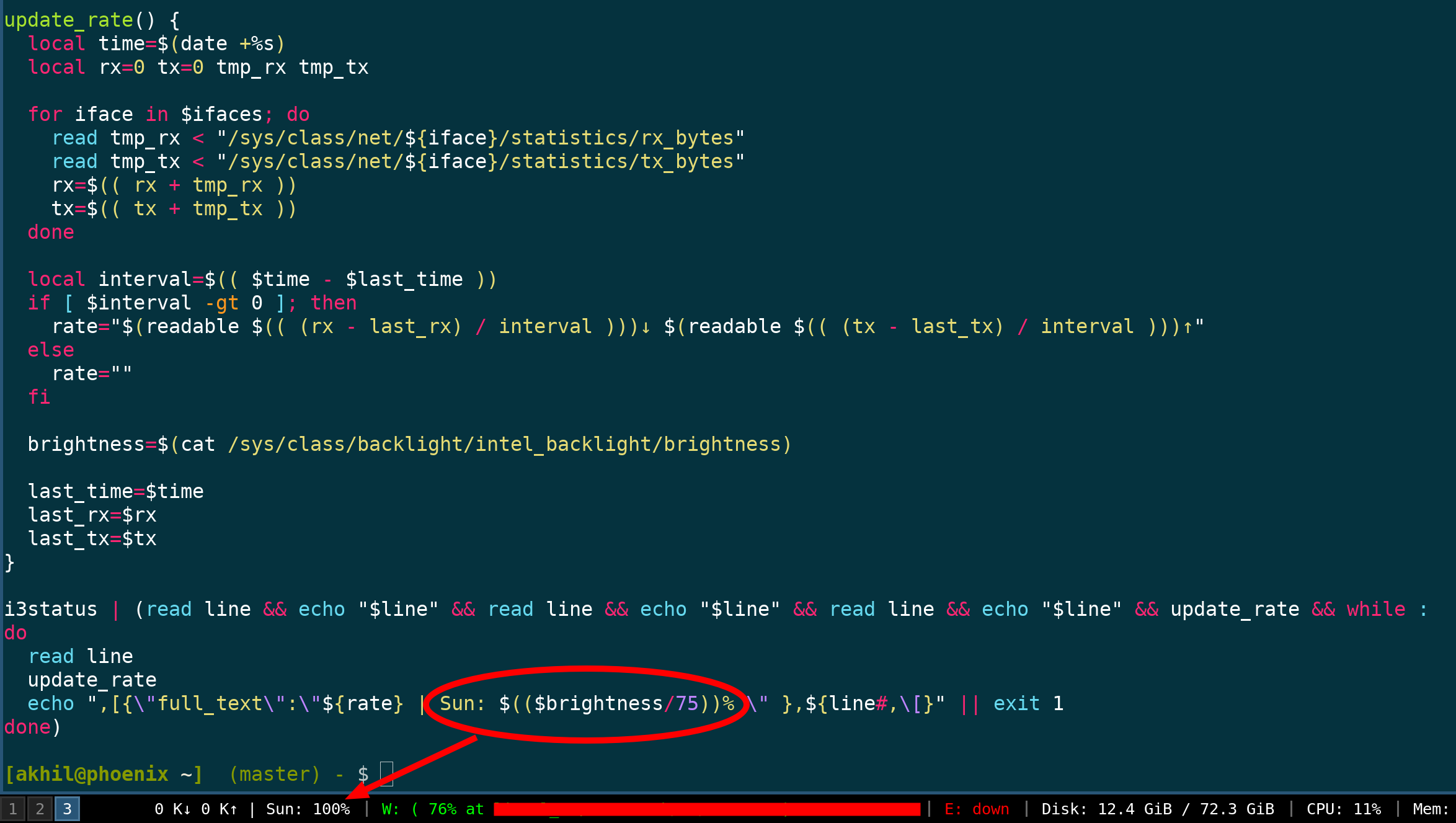
I’ve been using Linux for a long time, but I was never entirely happy with the desktop environment options available. Until last year, Xfce was the closest to what I consider a good compromise between features and performance. Then I found i3, an amazing piece of software that changed my life.
i3 is a tiling window manager. The goal of a window manager is to control the appearance and placement of windows in a windowing system. Window managers are often used as part a full-featured desktop environment (such as GNOME or Xfce), but some can also be used as standalone applications.
Follow this method
- copy the script to /usr/local/bin
net-speed-and-brightness.sh
#!/bin/sh
# Authors:
# - Moritz Warning <[email protected]> (2016)
# - Zhong Jianxin <[email protected]> (2014)
# - Akhil Jalagam <[email protected]> (2019)
#
# See file LICENSE at the project root directory for license information.
#
# i3status.conf should contain:
# general {
# output_format = i3bar
# }
#
# i3 config looks like this:
# bar {
# status_command exec /usr/share/doc/i3status/contrib/net-speed.sh
# }
#
# Single interface:
# ifaces="eth0"
#
# Multiple interfaces:
# ifaces="eth0 wlan0"
#
# Auto detect interfaces
#ifaces=$(ls /sys/class/net | grep -E '^(eth|wlan|enp|wlp)')
ifaces="enp2s0 wlp3s0"
last_time=0
last_rx=0
last_tx=0
rate=""
readable() {
local bytes=$1
local kib=$(( bytes >> 10 ))
if [ $kib -lt 0 ]; then
echo "? K"
elif [ $kib -gt 1024 ]; then
local mib_int=$(( kib >> 10 ))
local mib_dec=$(( kib % 1024 * 976 / 10000 ))
if [ "$mib_dec" -lt 10 ]; then
mib_dec="0${mib_dec}"
fi
echo "${mib_int}.${mib_dec} M"
else
echo "${kib} K"
fi
}
update_rate() {
local time=$(date +%s)
local rx=0 tx=0 tmp_rx tmp_tx
for iface in $ifaces; do
read tmp_rx < "/sys/class/net/${iface}/statistics/rx_bytes"
read tmp_tx < "/sys/class/net/${iface}/statistics/tx_bytes"
rx=$(( rx + tmp_rx ))
tx=$(( tx + tmp_tx ))
done
local interval=$(( $time - $last_time ))
if [ $interval -gt 0 ]; then
rate="$(readable $(( (rx - last_rx) / interval )))↓ $(readable $(( (tx - last_tx) / interval )))↑"
else
rate=""
fi
# show brightness
brightness=$(cat /sys/class/backlight/intel_backlight/brightness)
last_time=$time
last_rx=$rx
last_tx=$tx
}
i3status | (read line && echo "$line" && read line && echo "$line" && read line && echo "$line" && update_rate && while :
do
read line
update_rate
echo ",[{\"full_text\":\"${rate} | Sun: $(($brightness/75))% \" },${line#,\[}" || exit 1
done)</pre>
</div>
In the above script you can change /sys/class/backlight/intel_backlight/brightness based on your backlight model.
- update i3 config with the following
# control brightness
bindsym XF86MonBrightnessUp exec intelbacklight -inc 500 # increase screen brightness
bindsym XF86MonBrightnessDown exec intelbacklight -dec 500 # decrease screen brightness
# status bar
bar {
status_command /usr/local/bin/net-speed-and-brightness.sh
}
Now reload the i3 config using Mod+Shift+r
Finally, you will see the net speed and brightness in status bar